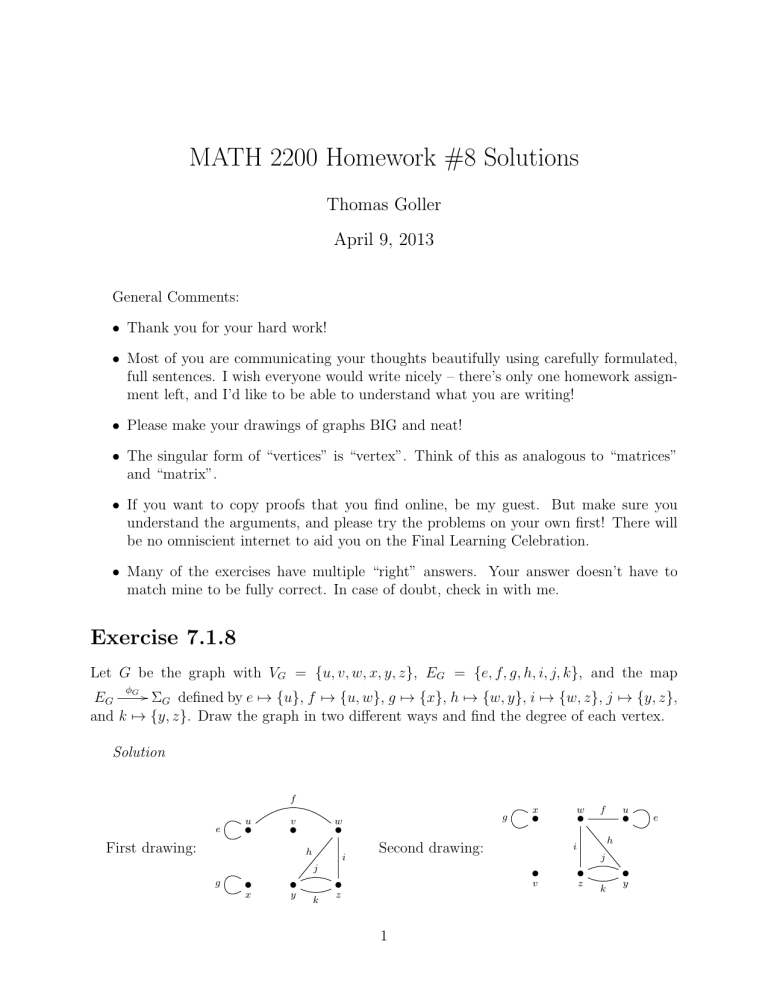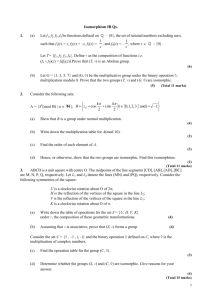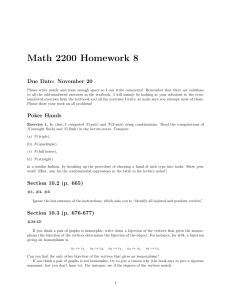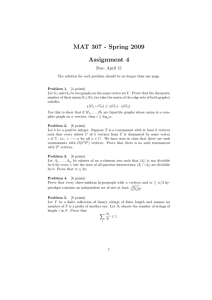MATH 2200 Homework #8 Solutions Thomas Goller April 9, 2013
advertisement

MATH 2200 Homework #8 Solutions
Thomas Goller
April 9, 2013
General Comments:
• Thank you for your hard work!
• Most of you are communicating your thoughts beautifully using carefully formulated,
full sentences. I wish everyone would write nicely – there’s only one homework assignment left, and I’d like to be able to understand what you are writing!
• Please make your drawings of graphs BIG and neat!
• The singular form of “vertices” is “vertex”. Think of this as analogous to “matrices”
and “matrix”.
• If you want to copy proofs that you find online, be my guest. But make sure you
understand the arguments, and please try the problems on your own first! There will
be no omniscient internet to aid you on the Final Learning Celebration.
• Many of the exercises have multiple “right” answers. Your answer doesn’t have to
match mine to be fully correct. In case of doubt, check in with me.
Exercise 7.1.8
Let G be the graph with VG = {u, v, w, x, y, z}, EG = {e, f, g, h, i, j, k}, and the map
φG
! ΣG defined by e !→ {u}, f !→ {u, w}, g !→ {x}, h !→ {w, y}, i !→ {w, z}, j !→ {y, z},
EG
and k !→ {y, z}. Draw the graph in two different ways and find the degree of each vertex.
Solution
f
e
First drawing:
u
•
v
•
g
w
•
h
i
Second drawing:
j
g
•
x
•
y
k
x
•
1
u
f
h
•
j
v
z
•
i
•
•
w
•
z
k
•
y
e
The degrees of the vertices are:
deg(u) = 3,
deg(v) = 0,
deg(w) = 3,
deg(x) = 2,
deg(y) = 3,
deg(z) = 3.
Exercise 7.1.9
Claim. Let G = (V, E, φ) be a graph. Then the sum of the degrees of all vertices in G is
equal to twice the number of edges of G, namely
!
deg(v) = 2 · |E|.
v∈V
Proof. Let e ∈ E. If e is a loop, then e has only one endpoint and contributes 2 to the degree
of that endpoint. If e is not a loop, then e has two distinct endpoints and contributes 1 to
the degree of each endpoint. In each case, e contributes
" 2 to the sum of the degrees of all
vertices. Since this is true for each e ∈ E, we see that v∈V deg(v) = 2 · |E|.
Exercise 7.1.10
Claim. Let G = (V, E, φ) be a graph. Then the number of vertices in G with odd degree is
even.
"
Proof #1. By Exercise 7.1.9, v∈V deg(v) is even. A sum of integers is even if and only if
the number of odd terms in the sum is even. Thus the number of vertices with odd degree
must be even.
Proof #2. Write V = Veven $ Vodd , where Veven is the set of vertices in V with even degree,
and Vodd is the set of vertices in V with odd degree. By Exercise 7.1.9,
!
!
!
!
0≡
deg(v) =
deg(v) +
deg(v) ≡ 0 +
1 = |Vodd | (mod 2),
v∈V
v∈Veven
v∈Vodd
v∈Vodd
so |Vodd | is even.
Exercise 7.2.6
In Example 7.2.5, I wrote down an isomorphism of the graphs
v1
e1
G1 =
•
v2
•
w1
e2
f1
and G2 =
•
•
v3
w2
•
f2
•
w3
Write down the only other isomorphism of these two graphs, and check that your bijections
are compatible.
2
Solution: Define {v1 , v2 , v3 }
#
ν
!
{w1 , w2 , w3 } by ν(v1 ) = w1 , ν(v2 ) = w3 , and ν(v3 ) =
! {f1 , f2 } by #(e1 ) = f2 and #(e2 ) = f1 . Let φ1 and φ2 denote the
w2 . Define {e1 , e2 }
functions from the edges of the graphs G1 and G2 to their endpoints. Then
φ2 (#(e1 )) = φ2 (f2 ) = {w1 , w3 } = {ν(v1 ), ν(v2 )},
where φ1 (e1 ) = {v1 , v2 },
φ2 (#(e2 )) = φ2 (f1 ) = {w1 , w2 } = {ν(v1 ), ν(v3 )},
where φ1 (e2 ) = {v1 , v3 },
and
so the bijections ν and # define an isomorphism between G1 and G2 .
Exercise 7.2.12
The fourth condition in the Note 7.2.11 is not stated very precisely. Using Examples 7.2.14
and 7.2.15 as guidance, state some precise conditions that capture part of what this fourth
condition might mean.
Solution:
• If a graph G contains a loop, then any graph isomorphic to G must contain a loop.
• If a graph G contains multiple edges, then any graph isomorphic to G contains multiple
edges.
• If a graph G has two adjacent vertices of degrees d1 and d2 , then any graph isomorphic
to G must also have two adjacent vertices of degrees d1 and d2 .
• Let G = (V, E, φ) be a graph. Choose any v ∈ V . The vertices in V that are adjacent
to v have certain degrees, say d1 , . . . , dn . Any graph that is isomorphic to G must have
a vertex whose adjacent vertices have that same list of degrees, in some order. And
this is true for every vertex v ∈ V .
Exercise 7.2.13
Why do isomorphic graphs satisfy the above four conditions?
Solution: If two graphs G = (VG , EG , φG ) and H = (VH , EH , φH ) are isomorphic, then
# !
ν !
VH and a bijection EG
EH . Since bijective sets have the
there is a bijection VG
same number of elements, we see that |VG | = |VH | and |EG | = |EH |, which proves the first
two conditions in Note 7.2.11. Since the bijections ν and # are compatible, we see that for
every v ∈ VG , deg(ν(v)) = deg(v), which proves the third condition. The fourth condition is
stated imprecisely and is meant to capture the idea that isomorphic graphs differ only in how
they are drawn, but not in their “structure” (where “structure” encompasses the “relative
arrangement of vertices of specific degrees”).
3
Exercise 7.2.17
(a) An isomorphism of the graphs
v1
•
w1
e2
e1
and
v2
e4
•
f3
e3
•
w2
f2
•
f4
f1
f5
•
e5
v3
•
•
e6
v4
•
f6
w3
w4
is given by the bijections
ν
{v1 , . . . , v4 }
!
{w1 , . . . , w4 }
defined by ν(vi ) = wi for 1 ≤ i ≤ 4;
{f1 , . . . , f6 }
defined by #(ei ) = fi for 1 ≤ i ≤ 6.
#
{e1 , . . . , e6 }
!
(b) The graphs
•
•
•
•
•
•
and
•
•
•
•
are not isomorphic. The left graph has a vertex of degree 4, while the right graph does
not.
(c) An isomorphism of the graphs
v1
e1
•
e2
v2
w2
•
f1
•
f4
e3
v3
•
e4
e5
•
e6
v4
and
w1
•
f2
w3
•
f3
•
f5
w4
•
f6
•
v5
w5
is given by the bijections
{v1 , . . . , v5 }
{e1 , . . . , e6 }
ν
!
#
{w1 , . . . , w5 }
defined by ν(vi ) = wi for 1 ≤ i ≤ 5;
{f1 , . . . , f6 }
defined by #(ei ) = fi for 1 ≤ i ≤ 6.
!
4
(d) The graphs
•
•
•
•
•
•
•
and
•
•
•
•
•
•
•
are not isomorphic because the left graph has a pair of adjacent vertices that are degree
2, while the right graph does not. Another difference is that the left graph has a vertex of
degree 4 whose adjacent vertices have degrees (1, 1, 1, 2), while the only vertex of degree
4 in the right graph has adjacent vertices with degrees (1, 1, 2, 2).
(e) The graphs
•
•
•
•
•
•
•
•
and
•
•
•
•
•
•
•
•
•
•
are not isomorphic because the right graph has a pair of adjacent vertices that are each
degree 4, while the left graph does not. Another difference is that the left graph has a
vertex that is adjacent to two vertices of degree 4, while the right graph has no such
vertex.
Exercise 7.2.18
Definition. Let A and B be sets. An isomorphism of A and B is a bijective function
f
! B . We say that two sets A and B are isomorphic if there is an isomorphism of A
A
and B.
The idea behind this definition is that the labels of the elements of a set are not important
to its “structure”. Indeed, a set has no structure, other than the number of elements it
contains. There is a bijection between two sets A and B if and only if A and B have the
same number of elements. Thus A and B are isomorphic if and only if A and B have the
same number of elements. The notion of “number of elements” makes sense for finite sets,
but it doesn’t generalize well to infinite sets. This definition, however, does! It turns out
that there are different “sizes” of infinity: the size of Z is the same as the size of Q, but is
smaller than the size of R. What this means is that one can construct a bijection between Z
and Q, but one can prove that it is impossible to construct a bijection between Z and R. If
you’re interested in these different sizes of infinity, I’d be happy to show you the cute proofs
of these facts!
5







